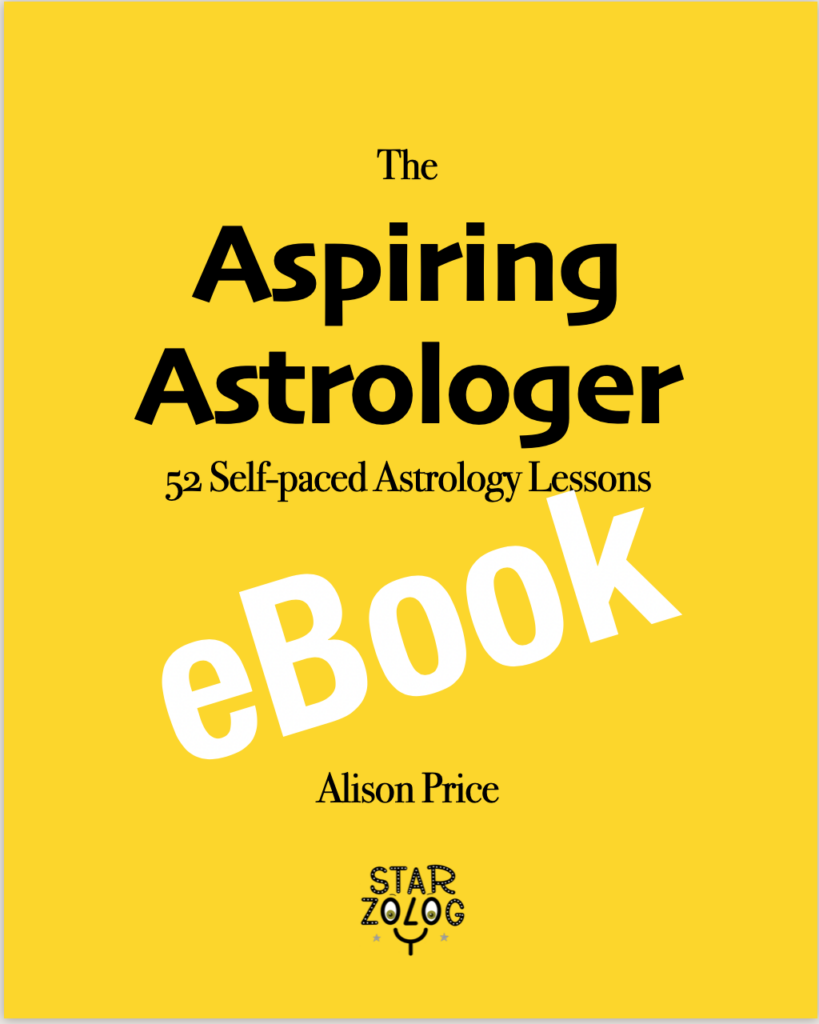Chart Complexes
There are many techniques which you can use to read a birth chart and one highly popular method is with chart complexes.
A complex contains everything to do with a particular feature in a chart
You can have house complexes, point (Ascendant, Lunar node, Part of Fortune etc.) complexes and planetary complexes.
In this post we’re going to look at planetary complexes.
A Planetary Complex
Each planet in your chart will have its own complex.
There will be the Sun complex, the Moon complex, Jupiter’s complex and even Eris’ complex.
Planetary Complex Components
The five components that go to make a planetary complex are the planet’s:
- Meaning
- Sign
- Aspects
- Position
- Influence
Let’s have a look at each planetary complex component in detail.
1 Planet’s Meaning
The planet in question always retains its core meaning.
For example, Mercury will always have the urge to communicate, and Mars will always have the urge to initiate actions.
Pay attention to a planet’s keywords.
2 Planet’s Sign
When considering a planet in a sign you always want to find if there is any essential dignity.
This feature itself is probably the most prominent influence when considering a planets complex.
Rulership
A planet in rulership is resilient.
Planets in rulership can work at their full potential 100% of the time.
Any planet in its own sign has the urge to dominate and express itself in the person’s life.
This is likely to be one of the top planets in the chart.
Exaltation
A planet in exaltation, is robust and walks towards the light.
If there is an exalted planet and there are no planets in rulership, the exalted planet will push itself forward into the person’s life.
Fall
A planet in fall, will benefit from support from other planets to achieve its potential.
Planets in fall can easily be dragged down by challenges from the malefic planets.
Detriment
A planet in detriment will struggle to express itself in this person’s life.
This planet will need a lot of work to see its positive energy.
A debilitated planet is likely to effortlessly turn towards the dark side.
Face
A planet with face, steps forward and wants to help the person.
Term
A planet with term, is usually a nice-to-have and will support any planet struggling to move forward.
3 Planetary Aspects
Challenges or support from other planets are shown by the aspects.
Most planets have aspects to the other planets.
Consider the nature of the aspects themselves and the planet making the aspect.
Hard Aspects
The hard aspects are the opposition, the contra-parallel, the square, the semi-square and the sesquiquadrate.
Hard aspects bring challenges and energy is required to overcome the friction or obstacles expressed by the aspect.
Soft Aspects
The soft aspects are the trine and the sextile.
Soft aspects bring ease and support and boost the planet in the nature of the other planet making the aspect.
Neutral Aspects
The neutral aspects are the conjunction and the parallel.
Impartial aspects may be supportive or non-energetic.
These unbiased aspects add robustness to the planet in question.
Unaspected Planets
A planet is unaspected if it does not receive a Ptolemaic aspect from another planet.
Do not consider aspects from the points when determining unaspectedness.
4 Planetary Position
There are some positions that planet may have in a chart which are more important than other placements.
It’s like being in the right place at the right time.
High in the Chart
When a planet is high and near the top, at the most elevated position or in the Midheaven Gauquelin sector in a chart, it becomes more significant.
A planet in this position supports what you do in the outside world and in the public domain.
East in the Chart
When a planet is placed in the east, at the Ascendant position, either rising or in the Ascendant Gauquelin sector or bothit attains more significance.
A planet in this position supports your personal brand, message and the impression you make on others.
Proximity to the Sun
When a planet has solar proximity by being either cazimi, combust or under-the-beams it may add to, or detract from, the planet’s ability to express itself.
A planet in this position needs further consideration.
5 Planetary Influence
Through the principle of chart division, we can slice the chart up in several ways.
A planet may have influence over several sectors of the chart although some planets have no sway through chart division.
Hemisphere Ruler
There are four hemispheres in each chart, the Eastern, Western, Northern and Southern hemispheres.
When a planet is a hemisphere ruler by being on the cusp of the hemisphere, it brings a broad influence over half of the chart.
Either the self (Eastern hemisphere), others (Western hemisphere), the public life (Southern hemisphere) or the private life (Northern hemisphere).
If it is a tenant in the hemisphere that it rules, it increases its authority.
Quadrant Ruler
There are four quadrants in each chart the first, second, third and fourth quadrants.
When a planet is a quadrant ruler by being on the cusp of the quadrant, it has influence over one quarter of the chart.
If the planet is a tenant in the quadrant which it rules, it gains dynamic power.
House Ruler
There are twelve houses in each chart.
When a planet is a house ruler by being on the cusp of the house, it impacts the area of life shown by the house.
If the planet is a tenant in a house which it rules, is intensifies its dominance.
Triple Division Ruler
There are three triple divisions in a chart, the first, second and third triple division.
When a planet is a triple division ruler by being on the cusp of the division, it impacts the Me (first triple division), We (second triple division), or You (third triple division), message shown by the division.
If the planet is a tenant in a triple division which it rules, is intensifies the main keyword of the division (Me, We or You).
Influence Assessment
When analyzing a birth chart, go through and work out every planet complex and determine which are the dominant planets within a chart.
Having attained a full picture of each planet’s complex you can decide just how influential each planet is in the chart.
This may bring up some surprising results.
It is often at this time that you realize that perhaps the Sun and the Moon are not as influential as you thought and maybe Uranus is a dominant planet within a chart.

Example Chart Steve Wozniak
Sun Planetary Complex
Meaning: Identity, ego and self-awareness.
Sign: Leo dignity sign ruler
Aspects Soft: Trine Chiron and sextile Neptune.
Aspects Neutral: Conjoined Pluto.
Position: 11th House. Dispositor tree top line.
Influence: Rules and is in the 11th House.
Moon Planetary Complex
Meaning: Feelings, reactions and needs.
Sign: Cancer in dignity sign ruler.
Aspects Hard: Square Mars.
Aspects Soft: Trine North Node
Aspects Neutral: Conjoined Venus.
Position: 10th House. Dispositor tree top line.
Influence: Cancer is intercepted so the Moon has no place to rule.
Mercury Planetary Complex
Meaning: Languages, ideas, thinking and trade.
Sign: Virgo dignity well placed.
Aspects hard: Semi-square Mars and square Chiron.
Aspects neutral: Conjunct and parallel Saturn so a double whammy.
Position: 12th house. Dispositor tree top line.
Influence: Rules Chart, rules and is in the Eastern hemisphere, rules and is in the Northern hemisphere, rules 1st quadrant, rules 4th quadrant, rules 1st house, 10th house and 12th house.
Jupiter Planetary Complex
Meaning: Growth, vision and luck.
Sign: Pisces retrograde, in dignity, has face essential dignity and is traditional sign ruler.
Aspects soft: Water Grand Trine with Mars and Uranus. Note these are the only Jupiter Aspects.
Position: In 6th house. Dispositor tree top line.
Influence: Rules and is in the Western hemisphere, rules and is in the 2nd quadrant and rules and is in the 6th House
Uranus Planetary Complex
Meaning: Computers and the internet, lateral thinking and breaks.
Sign: Cancer, no essential dignity.
Aspects soft: Water Grand Trine with Mars and Jupiter.
Aspects hard: Square Neptune.
Aspects neutral: Parallel Pluto.
Position: Most Elevated, Midheaven Gaquelin Sector and 10th house.
Influence: Rules 5th house.
Transiting and Progressed Planets
The planetary complexes indicate how that planet will fare and express itself for this person when it influences the chart by transit or progression.
Any planet which is weaker in the natal chart, when transiting or progressing the chart by aspect is likely to be weaker as well.
To know a planet’s natal strength can help determine whether as a forecast indicator it will be influential or not for this individual.
This shows up in instances where perhaps in a chart with a weak Saturn complex, and therefore their Saturn Return is not as challenging for that person as it is for the person whose Saturn is the most dominant planet in the chart by complex.
Warmly,
Alison

Pin this to read later
Aspiring Astrologer Activity
In your astrology journal and referencing your birth chart and a current ephemeris, please do the following:

Natal
- List the five key features of Planetary Complexes.
- Choose every planet from the Sun to Pluto and list their Planetary Complexes.
- Select the planet with most substantial and important Planetary Complex and fully analyze and get to know this planet.
Transits
- See which house your most important planet (by planetary complex) is transiting today.
- List the aspects it will make to your natal chart in the next twelve months and enter them in your calendar.
- On a monthly basis, monitor these transits and ponder how they are unlolding in your life.
Blogs and Articles
More astro information from our blog.
No Results Found
The page you requested could not be found. Try refining your search, or use the navigation above to locate the post.

USA Election Day 2024
Author: Alison Price - Published: October 2024 Election Day Chart Let the Astrology Speak I don't want to comment directly on the politics, or whom I believe is going to win this race or which party I support, or whether I'd take the red of the blue pill, because...
No Results Found
The page you requested could not be found. Try refining your search, or use the navigation above to locate the post.




